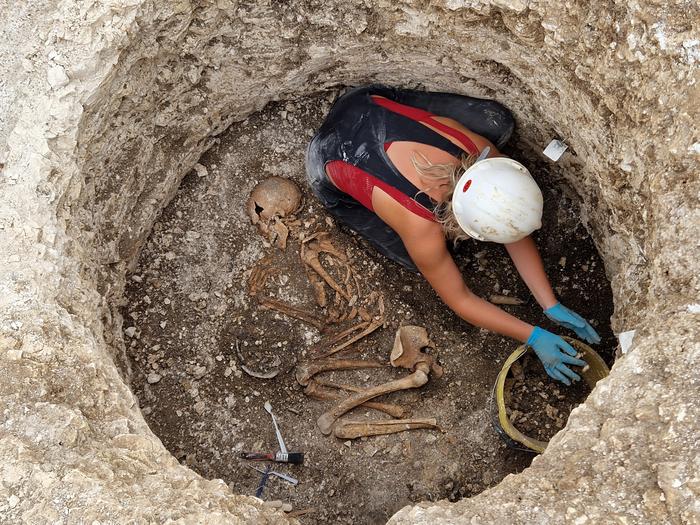
New findings published in the journal Nature suggest that women were at the top of British Iron Age societies. After examining ancient genomes uncovered in a cemetery in Dorset, an international research team determined that this community had a strong female-line descent, which may be a first for early Europe.
Uncovering Ancient Genomes
Durotrigian burial of a young woman from Langton Herring sampled for DNA (c) Bournemouth University. She was buried with a mirror (right panels) and jewellery, including a Roman coin amulet showing a female charioteer representing Victory.jpg (Credit: Bournemouth University.)
The research team — geneticists, led by Trinity College Dublin and archeologists from Bournemouth University — examined remains from Iron Age era burial grounds in Dorset, England, that were used before and after the Roman Conquest in 43 A.D. The team sequenced 50 genomes from this single community and determined that the female lineage was dominant.
“This was the cemetery of a large kin group,” said Lara Cassidy, assistant professor in Trinity’s Department of Genetics and lead author of the study, in a press release. “We reconstructed a family tree with many different branches and found most members traced their maternal lineage back to a single woman, who would have lived centuries before. In contrast, relationships through the father’s line were almost absent.”
The findings suggest that this community likely lived in a social system called a matrilocality.
“This tells us that husbands moved to join their wives’ communities upon marriage, with land potentially passed down through the female line,” said Cassidy in a press release. “This is the first time this type of system has been documented in European prehistory, and it predicts female social and political empowerment. It’s relatively rare in modern societies, but this might not always have been the case.”
Read More: What Was the Neolithic Revolution, and How Did It Change Human Societies?
Comparing Data in the Iron Age
Looking further into the data collected in Dorset, the research team decided to compare genetic findings from other Iron Age cemeteries, and though there wasn’t an abundance of data, the team did notice the same thing: strong female lineage.
“Across Britain, we saw cemeteries where most individuals were maternally descended from a small set of female ancestors,” said Dan Bradley, professor of population genetics in Trinity’s Department of Genetics, in a press release. “In Yorkshire, for example, one dominant matriline had been established before 400 B.C. To our surprise, this was a widespread phenomenon with deep roots on the island.”
Iron Age cemeteries, especially in Britain, are often not well-preserved. However, thanks to the burial rituals of a community known as the Durotriges, researchers obtained this DNA and other genetic information. The archeology team from Bournemouth University has been excavating a site near Winterborne, Kingston, since 2009 and noticed that women’s graves often had more decoration and furnishings.
Both the genetic and archeological evidence may change our general understanding of Iron Age societies.
Read More: Humans Shaped Ancient History Across 3 Ages: The Stone, Bronze, and Iron Age
When in Rome
It’s possible that this view of these ancient societies would not be such a surprise had it not been for the influence of Rome during the conquest. According to the study, the Romans found these matriarchal societies rather remarkable but may have written a skewed view of them to make the society seem less civilized.
“Beyond archaeology, knowledge of Iron Age Britain has come primarily from the Greek and Roman writers, but they are not always considered the most trustworthy,’’ said Miles Russell, the excavation’s director and co-author on the study, in a press release. “That said, their commentary on British women is remarkable in light of these findings.”
“It’s been suggested that the Romans exaggerated the liberties of British women to paint a picture of an untamed society. But archaeology, and now genetics, implies women were influential in many spheres of Iron Age life. Indeed, it is possible that maternal ancestry was the primary shaper of group identities,” says Russell.
With this new evidence, the research team now has a better understanding of what this society was like: a society with a deep respect for its ancestry and its leaders.
Article Sources
Our writers at Discovermagazine.com use peer-reviewed studies and high-quality sources for our articles, and our editors review for scientific accuracy and editorial standards. Review the sources used below for this article:
A graduate of UW-Whitewater, Monica Cull wrote for several organizations, including one that focused on bees and the natural world, before coming to Discover Magazine. Her current work also appears on her travel blog and Common State Magazine. Her love of science came from watching PBS shows as a kid with her mom and spending too much time binging Doctor Who.








Leave a Comment